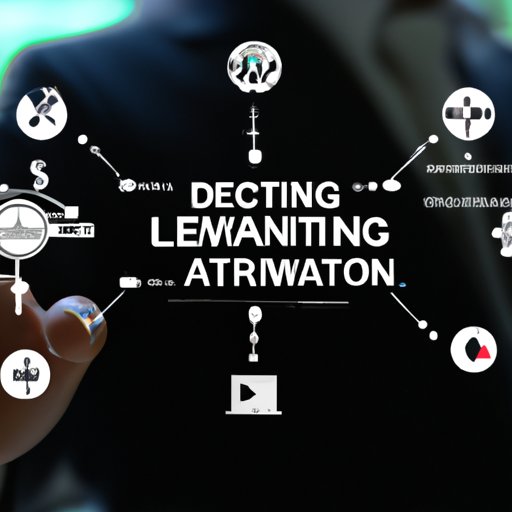Introduction
Deep learning AI is a subset of artificial intelligence (AI) that focuses on simulating the human brain’s ability to learn. It relies on algorithms and techniques such as supervised learning, unsupervised learning, and reinforcement learning to enable machines to “learn” from data and make decisions without being explicitly programmed. By leveraging the power of deep learning AI, businesses can automate tasks and processes, improve accuracy, and gain insights from data quickly and efficiently.
What is Deep Learning AI and How Does it Work?
At its core, deep learning AI is a type of machine learning algorithm that uses neural networks to process data and identify patterns. Neural networks are composed of multiple layers of interconnected nodes, which allow them to “learn” from data. As data passes through each layer of the network, the algorithm identifies patterns and adjusts its parameters accordingly. This enables the algorithm to “deeply” understand the data and make accurate predictions.
In order for deep learning AI to be effective, it must be trained with large amounts of data. This is known as supervised learning, where the algorithm is given labeled data sets so it can learn how to recognize certain patterns. Once the algorithm has been trained, it can then be used to make predictions based on new data sets. In addition, deep learning AI can be used for unsupervised learning, where the algorithm is given unlabeled data and must figure out the patterns by itself.
The basic components of a deep learning AI system include input layers, hidden layers, output layers, activation functions, and weights. The input layers take in the raw data, while the hidden layers process the data and detect patterns. The output layers produce the desired result, while the activation functions determine how the data is processed. Finally, the weights are used to adjust the connections between the different layers of the neural network.

A Comprehensive Guide to Deep Learning AI
Deep learning AI comes in various forms, including convolutional neural networks (CNNs), recurrent neural networks (RNNs), and generative adversarial networks (GANs). CNNs are used for image processing and computer vision tasks, while RNNs are used for natural language processing tasks. GANs are used for generating new data from existing data sets.
Common uses of deep learning AI include facial recognition, object detection, voice recognition, sentiment analysis, and text classification. Deep learning AI can also be used for fraud detection, medical diagnosis, autonomous driving, and recommendation systems. Additionally, deep learning AI can be used to create virtual assistants and chatbots that can interact with customers in real-time.
The Benefits of Deep Learning AI
Deep learning AI offers numerous benefits, such as increased efficiency, cost savings, and improved accuracy. According to a study conducted by McKinsey & Company, deep learning AI can reduce costs associated with manual labor by up to 90%. Additionally, deep learning AI can provide more accurate results than traditional methods, as it can detect subtle patterns in data that may otherwise be overlooked.
Another benefit of deep learning AI is its ability to automate tedious and repetitive tasks. For example, deep learning AI can be used to automatically categorize images or transcribe audio files, freeing up valuable time and resources. Furthermore, deep learning AI can help businesses make better decisions by providing insights into customer behavior and preferences.
Deep Learning AI in Modern Business
Deep learning AI is becoming increasingly important in modern business. Companies are using deep learning AI to automate mundane tasks and streamline their processes. For instance, deep learning AI can be used to analyze customer data and generate predictive models that can be used to personalize customer experiences. Additionally, deep learning AI can be used to detect anomalies in data and alert businesses of potential security threats.
Deep learning AI is also being used to enhance customer relationships. For example, companies are leveraging deep learning AI to develop virtual assistants and chatbots that can provide personalized customer service and recommendations. These technologies can help businesses build stronger relationships with their customers and increase customer loyalty.

The Future of Deep Learning AI
The future of deep learning AI looks very promising. According to a report from PwC, AI will add $15.7 trillion to the global economy by 2030. Additionally, deep learning AI will have a major impact on the job market, as many low-skill jobs will be replaced by automated processes. However, deep learning AI will also create new jobs, such as data scientists and AI engineers.
Deep learning AI is also expected to lead to increased automation in the near future. Autonomous vehicles, robotic manufacturing, and smart homes are just a few examples of the potential applications of deep learning AI. In addition, deep learning AI could revolutionize healthcare, as it could be used to diagnose diseases, predict outcomes, and recommend treatments.

The Role of Deep Learning AI in Automation
Deep learning AI plays a critical role in automation. It can be used to automate repetitive tasks, such as data entry and customer support. Additionally, deep learning AI can be used to improve productivity by speeding up processes and reducing errors. Finally, deep learning AI can be used to enhance security by detecting anomalies and threats in real-time.
Conclusion
Deep learning AI is a powerful tool that can be used to automate tasks, improve accuracy, and gain insights from data. It can be used for a variety of applications, such as facial recognition, object detection, and sentiment analysis. Additionally, deep learning AI can help businesses streamline their processes, enhance customer relationships, and improve security. The future of deep learning AI looks very promising, with potential applications in healthcare, autonomous vehicles, and robotic manufacturing.
(Note: Is this article not meeting your expectations? Do you have knowledge or insights to share? Unlock new opportunities and expand your reach by joining our authors team. Click Registration to join us and share your expertise with our readers.)
